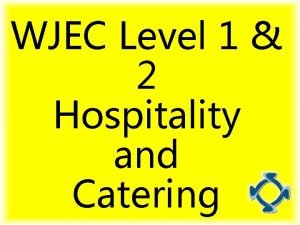Year 10 WJEC Level 12 Hospitality Catering LO


- Slides: 2

Year 10 WJEC: Level 1/2 Hospitality & Catering LO 4 Causes of food illness can be split into 3 categories: 1. Microbes – tiny microorganisms which can contaminate & spoil food - Bacteria - - Yeast - Mould 2. Chemicals, metals & poisonous plants 3. Allergies & intolerances 1. Microbes Bacteria: Can be good, or pathogenic & cause food poisoning. Yeast: used a lot in the food industry in bread & beer making. It is a fungi which reproduced by budding. It needs warm, acidic, sweet foods (it ferments sugars) so can spoil sweet foods such as orange juice. Mould: used in cheese making. A fungi with thread like filaments which spread into a food (they stay even when the visible mould is cut off). It needs warm, moist conditions and can spoil foods. Conditions needed for bacteria to multiply : Moisture - dried food has a longer shelf life Time - multiplies every 20 mins(binary fission) Warmth - multiply in warm conditions Food (high risk) – high in protein i. e. eggs, meat, fish. *Use weekdays to help remember(MTWF) 5 -63°C - The danger zone. Bacteria multiplies rapidly as it has warmth. High risk food should not be kept in the danger zone – you should only take food out of the fridge when ready to prepare it. 0 -5°C - Fridge temperature. This slows bacteria from multiplying as they do not get the warmth but does not completely stop or kill it. -18°C - Freezer temperature. This stops bacteria from multiplying as they do not get the warmth or moisture but does not completely kill it. 75°C+ - This kills bacteria. The core temperature of high-risk food such as meat should be cooked to at least 75°C, checked using a food probe 63°C+ - ‘Hot hold’ temperature. Cooked or reheated food must stay above 63° C (out of the danger zone) e. g. in buffets, deliveries. Checks should be carried out every 2 hours to ensure hot food maintains 63°C+ Cross contamination: When bacteria is transferred from one place to another - avoid! e. g. handling raw meat then touching ready to eat food such as salad; handling raw meat then touching equipment/door handle; sneezing into food and not washing hands after; using equipment for raw meat then ready to eat food; by storing raw and ready to eat foods together in a fridge Prevention during storage • Chill cooked foods within 90 minutes • Check and log temperatures regularly • Wrap high-risk food & store on correct shelves of fridge • Only take out the amount required for cooking • FIFO rotation of foods (old stock to front, new to the back) • Check dates of food regularly & date mark containers • Dried food should be correctly stored & covered Bacteria type Onset time Prevention during preparation & cooking • Personal hygiene (hands washed before cooking, after touching raw food, after coughing/sneezing, clean apron, blue plasters on cuts, hair nets) • Colour coded food equipment, boards/knives. • Only take food out of fridge when ready to prepare/cook • Separate ready to eat and raw foods • Check hot hold/fridge temperature every 2 hours Symptoms (side effects) Sources (where it comes from) Diarrhoea, stomach cramps, vomiting Diarrhoea (may be bloody), stomach cramps, vomiting. Diarrhoea, stomach cramps (no vomiting) Diarrhoea, vomiting, nausea, high temperature, aches & pains, chills Diarrhoea, stomach cramps, vomiting, nausea Diarrhoea, stomach cramps, Sudden vomiting & nausea, Raw meat, sea fish & eggs Fruits and vegetables Unpasteurized (raw) milk & poultry Duration of symptoms Salmonella Campylobacter E-coli Clostridium Perfringens Listeria Bacillus Cereus Staphylococcus Aureus O: 2 -3 days D: a week O: 12 -72 hrs D: Up to a week O: 2 days D: Up to 10 days O: Within hours D: Up to 2 days O: Up to 3 months D: Days – weeks O: 1 -16 hrs D: Up to 2 days O: 1 -6 hrs D: Up to 3 days Undercooked ground beef (faeces in intestines) Unpasteurized dairy. Raw fruit & veg - water on crops Raw meat, gravies, food left for long periods at room temperature Unpasteurized dairy products. Raw fruits & vegetables Ready-to-eat deli meats, pate & seafood Cooked rice being reheated Throat and mouth (i. e. chef coughing) Skin (i. e. chef not washing hands) Know how food can cause ill health 2. Chemicals, metal & plants - Chemicals: can be poisonous - cleaning products, bleach, fertilisers & pesticides in crops/farming, overuse of additives. - Metal: aluminium & tin can leach out of pans & tins when reacting with acidic food such as tomato, producing a metallic taste. Leftover food in tins should be transferred into a different container - not stored in the tin (e. g. half a tin of beans) - Plants: some plants can be poisoning e. g. some mushrooms, berries, rhubarb leaves 3) Allergies & intolerances Businesses must act responsibly towards this by • advising customers about ingredients in their food • label food and menus correctly • avoid contaminating food with allergens • recognise & know what to do if a customer has a reaction Allergy: A serious & possible life-threatening reaction to a food or ingredient. The common allergens are: 1. eggs 2. fish 3. milk 4. peanuts 5. gluten 6. sesame 7. celery 8. mustard 9. soybeans 10. molluscs ( mussels & oysters) 11. tree nuts ( hazelnut, almond, walnut, cashew ) 12. lupin ( a gluten free flour) 13. crustaceans ( prawn, crab, lobster) 14. sulphur dioxide/ sulphites ( a preservative) Symptoms of an allergy Visible: flushed skin, rash, swelling of skin & lips, difficulty breathing. Non-visible: swelling of tongue & throat, stomach pain can become unconscious - Can cause anaphylaxis shock (severe, possible fatal) Needs immediate treatment: Stay calm, call ambulance, reassure, use Epi. Pen if they have one How to achieve a distinction - Ensure you explain a range of ways to prevent food illness & include justification/ reasons (i. e. ensure raw meat is cut on a red board, & salad on a green board to prevent cross contamination from a high risk to a ready to eat food) - Ensure you can suggest a range of dishes suitable for intolerances - Include key temperatures in answers with justification & links to bacteria (e. g. hot hold ensures bacteria do not enter danger zone) Intolerance: Digestive issues/feeling unwell after eating certain foods. They cause a slower/less instant reaction compared to an allergic reaction. Causes digestive issues & stomach pains/bloating/diarrhea (rather than immune system response) Lactose intolerance: Cannot digest lactose (a sugar in milk) properly so bacteria in the intestine have to break it down which then produce gas Avoid: milk & dairy (yogurt, cheese, butter Alternatives: lactose free dairy/milk/yogurt Dairy free milks such as almond, soya, rice Coeliac/gluten intolerance: Reaction to gluten - in wheat, barley, oats, rye. Most flour is made from wheat so cannot eat food made from wheat (pasta, bread, pastry, cakes etc). As well as the symptoms they can also lack energy (lack of carbohydrates) Alternatives: Gluten free flour or other products such as bread. Almond flour, gram flour, linseed. Coeliac: eating gluten cause long term issues Gluten intolerance: eating gluten = short term discomfort Bacteria - microscopic organisms that multiply (pathogenic=harmful) Key Terms Yeast - a microscopic fungus that can ferment sugar (produce alcohol & CO 2) Mould - a furry growth of fungi that can grow and spoil food Cross contamination - When bacteria is transferred from one place to another Danger zone – bacteria multiplies most as it is warm (5 -63 °C) FIFO – First in first out – new stock is put behind old stock, so old stock is used first 90 -minute rule – cooked food should be cooled and refrigerated within 90 minutes Hot hold - cooked or reheated food is held hot prior to and during service to consumers (at 63 °C) Binary fission - bacteria makes a copy/splits into two every 20 minutes in the correct conditions Personal hygiene – the cleanliness of the food handler (i. e. hands washed, apron on, hair tied up) Kitchen hygiene – the cleanliness of the kitchen & work area (i. e. clean benches) Onset – the time between eating the contaminated food and symptoms appearing Duration – the time the person has the symptoms Symptoms – the side effects of something (i. e. a symptom of a cold is a runny nose) Sources – where something comes from (i. e. a source of salmonella is eggs) Allergy – a more severe immune response/reaction to something Intolerance – an inability to eat something without adverse effects (i. e. gluten) Anaphylaxis – a severe and potentially fatal reaction to something especially nuts Coeliac disease - a condition where immune system attacks the tissues when gluten is consumed. Gluten – a protein found in wheat flour, barley & rye (wheat flour - in bread, pastry, pasta, cakes) Lactose – a sugar found in milk (milk is in dairy products such as yogurt, cheese, cream)

Year 10 WJEC: Level 1/2 Hospitality & Catering Legislation Important to protect health It also protects business as: - Staff are trained correctly - Working conditions are good so staff can comply - Prevent customers making false claims LO 4 Law 2. Food hygiene regulations (&HACCP) Require food to be stored, handled, cooked & served safely & hygienically Apply to all food businesses who must ensure: - Food is produced safely 3 laws/pieces of legislation 1. Food Safety Act 2. Food Hygiene Regulations 3. Food Labelling Regulations (personal hygiene, pest control, staff training, cleaning & temperature records) - Records of suppliers are kept to trace where food came from Law 1: Food Safety Act Cover all food production & sale chain. (production, processing, storage, distribution & sale) Safe to eat (nothing unsafe added) What people expect (e. g. not food which is meant for pets) Not misleading (e. g. not horse meat in a lasagne) Law 3. Food labelling regulations To inform and educate consumers about food they choose to buy. Packaging must be: • Clear & easy to read/understand • Permanent • Easily visible • Not misleading The following must be shown by law (mandatory) Name of the food List of ingredients Ingredients causing allergies or intolerances Quantity/weight Use by date Storage Business name & address of business name Country of origin/place of provenance Instructions for use/cooking instructions Nutritional information (energy, fat, saturated, carbohydrates, sugars, protein, salt, vitamins & minerals) HACCP example for a takeaway Stage Potential hazard (hazard analysis) Purchasing Controls in place (Critical control point) Suppliers may not be hygienic Food may be out of date Meat may not be fresh Delivery van temperature in danger zone Fridge may not be 0 -5 Dry storage may be contaminated by pests Ready to eat food may be contaminated by meat Meat may contaminate ready to eat food Meat may be in danger zone for too long Cross contamination by food handler Meat may not be thoroughly cooked Cross contamination by food handler Food may enter danger zone Contamination by packaging Food not washed off equipment properly Walls and surfaces get food trapped in from splashed etc Scraps attract pests Suppliers visited to check measures Check dates on arrival Check temp of van Reject order if not met Regular checks & records logged Regularly checked and serviced Well ventilated, clean dry stores Use FIFO Store separately Meat only taken out of fridge when ready to prep Personal hygiene checks and training Cook to 75 C, use a Food probe and Timer Use tongs / serving equipment – not hands Use hot hold – 63 Clean storage, protected from pests Dishwasher Daily cleans at end of day Weekly deep cleans Secure bins, collected weekly, outside Storage Preparation Cooking Serving Washing up Use by date – must be used by to prevent food illness. Best before date - not harmful to eat after this date but quality reduced to ensure the food an establishment produces is safe to eat. Qualities: Responsibilities: - Communication • Carry out routine or unplanned visits - Negotiation • Follow up outbreaks of food poisoning - Ability to explain laws • Follow up complaints from the public - Ability to work methodically • Collect samples for testing - Problem solving • Give hygiene star ratings - Time management • Give evidence in court - Ability to work with people from all backgrounds • Give the owners advice • Give talks at public meetings and exhibitions Qualifications : • Check documentation (temp logs, cleaning logs) - A degree in environmental health or food science • Take photos, videos, drawings, interviews Powers: 1. Prohibition Notice - closed until any problems have been fixed. 2. Improvement Notice - must be acted on within a certain time limit 3. Prosecute those who do not comply with the law Food businesses should ensure they meet food safety & hygiene regs using HACCP systems to ensure they show due diligence (being able to prove reasonable actions were taken to avoid risk) HACCP = hazard analysis critical control point (a system to identify hazards & minimise risks): 1. Create a table or flow chart of the process 2. Analyse each step to identify the hazard 3. Identify what can be done to control/prevent the hazard 4. Set guidelines for each control/prevention (critical control points/limits) e. g. fridge temperature 5. Keep reviewing the system ingredients Traffic light labelling This is voluntary but provides a summary of the nutritional content (energy, fat, sugar & salt) so consumers can compare & see ‘at a glance’ It also shows a percentage of the reference intake e. g. If it says 49% for fat, it means the portion contains nearly half of the recommended fat intake for the day Red = high, amber = medium, green = low EHO (Environmental Health Officer) Enforce environmental health laws by inspecting premises in order Laws and the EHO Know how food can cause ill health Waste disposal Legislation - a law or set of laws Key Terms Prosecute – take someone to court for committing a crime Mandatory – required by law; compulsory Due diligence - reasonable steps taken by a person to avoid committing an offence Food Safety Act – law to ensure companies treat human food in a controlled and managed way Food Hygiene Regulations – law to ensure companies make sure that their activities are carried out hygienically. Food Labelling Regulations – the information and standards regarding information of food packaging/labels. Food Standards Agency - responsible for food safety and food hygiene in England, Wales & Northern Ireland. Country of origin/place of provenance – where the food comes from Traffic light label - a system where red, amber & green are used to represent high, medium or low amounts of sugar, fat, salt etc Reference intake - how you the maximum amount of calories and nutrients you should eat in a day EHO - Enforce environmental health laws by inspecting premises in order to ensure the food an establishment produces is safe to eat. Documentation - documents that provide information or evidence or that serves as a record. Prohibition notice – must stop selling food straight away – cannot resume until actions to remove or control the risk are removed. Improvement notice - when a restaurant doesn’t comply with hygiene laws - needs to be fixed by a certain time (can stay open) HACCP – (Hazard analysis critical control point) - a management system in which food safety is addressed through the analysis & control of hazards throughout the whole process. Hazard analysis - deciding what might be a hazard, and what should be done if someone or something is exposed to this hazard. Critical control point - a step in Food Handling where controls can be applied to prevent or reduce any food safety hazard.


